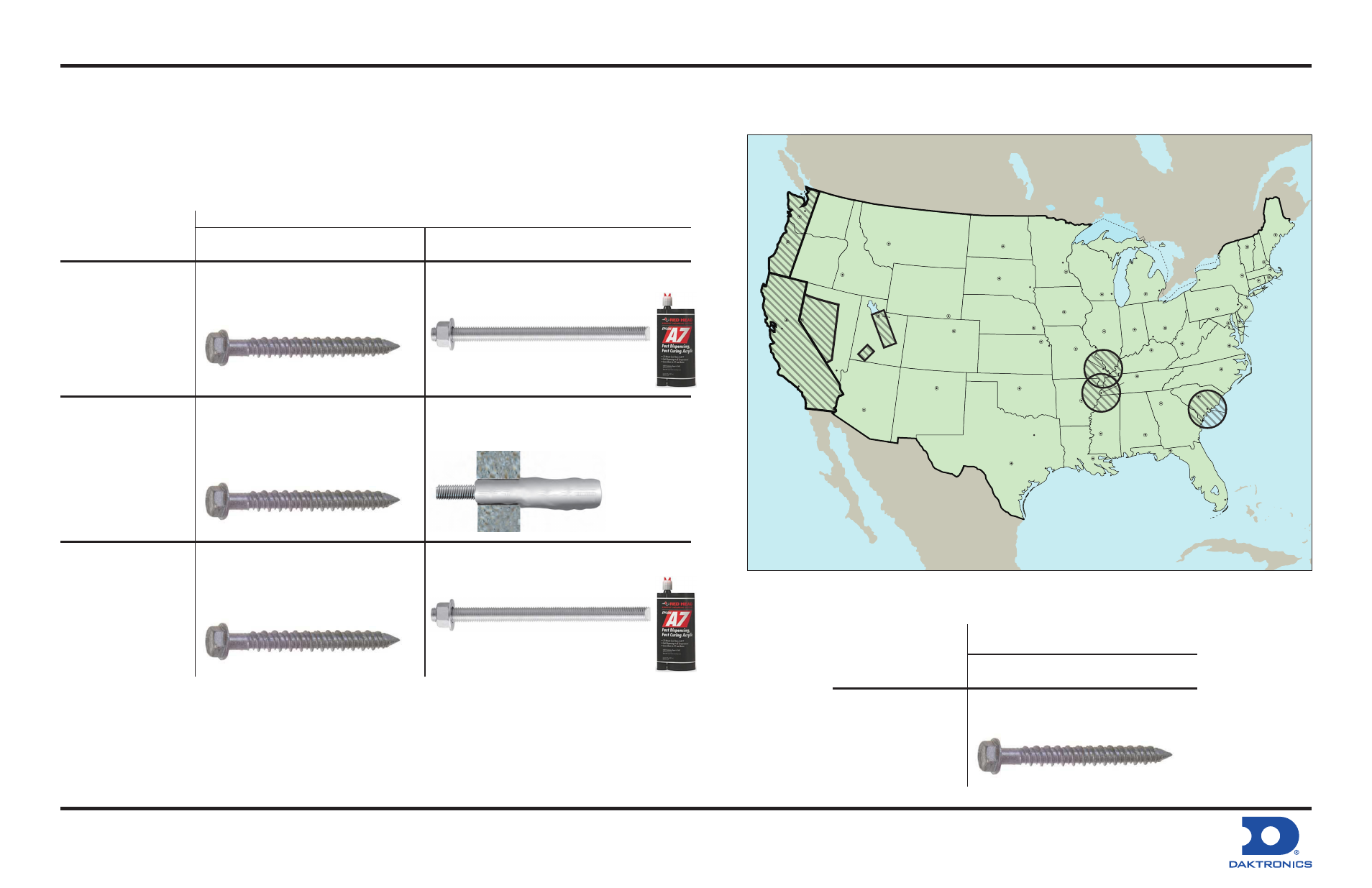Canada united states mexico, Cuba – Daktronics Sportsound Indoor (SSN-100/150) User Manual
Page 37

Anchorage Recommendations For Daktronics Standard Indoor Sound (SSN-100)
201 Daktronics Drive, PO Box 5128, Brookings, SD 57006
Phone: 1-800-325-8766 or 605-692-0200 Fax: 605-697-4746
www.daktronics.com/support
DD2670868 Rev 0
6 November 2013
The anchors listed have installation requirements specific to their intended use and must be followed. The installer will
ensure proper drilling of CMU hollow block to prevent blowout of the internal block wall. The following anchors correspond
to the regions shown in Figure 22-1 of ASCE 7-05, modified in this document to give clear representation of seismic zones.
Reference
DWG-1152497 for installation procedures of the speaker array.
Wall Material
Speaker Array Anchor Recommendations (by Region)*
Contiguous US – EXCLUDING
shaded areas of map
Contiguous US, Alaska, & Hawaii – INCLUDING
shaded areas of map
Concrete, normal weight,
3000 psi; minimum
member thickness 4"
1/4" ITW Red Head Tapcon concrete
anchor, 1" minimum embedment depth
ITW A7 Red Head Epoxy Adhesive with 1/4"
threaded rod, 1-1/2" minimum embedment depth
Hollow CMU Block
ASTM C90 CMU Type
1/4" ITW Red Head Tapcon concrete an-
chor, 1" minimum embedment depth defined
as the distance from the concrete masonry
unit surface to the bottom of the fastener
ITW A7 Red Head Epoxy Adhesive with 1/4" diam-
eter threaded rod and stubby screen tube, 2-1/4"
minimum embedment (screen length) depth
Grouted CMU Block
ASTM C90 CMU Type,
minimum grout strength
2000 PSI
1/4" ITW Red Head Tapcon concrete an-
chor, 1" minimum embedment depth defined
as the distance from the concrete masonry
unit surface to the bottom of the fastener
ITW A7 Red Head Epoxy Adhesive with 1/4"
threaded rod, 1-1/2" minimum embedment depth
DISCLAIMER: The following are anchorage types suggested based on the wall construction type. Daktronics makes no warranties with regard to the suggested anchorage types, and does not
represent that these anchorage types will comply with the local codes of the project site. The installing party is solely responsible for designing the anchorage and ensuring that the anchorage
used conforms to the codes of the local jurisdiction.
*Alaska and Hawaii not shown – these states would be completely shaded.
MT
Columbia
Raleigh
Richmond
Charleston
Columbus
Frankfort
Nashville
Milwaukee
Annapolis
Dover
Harrisburg
Trenton
Albany
Montpelier
Hartford
Oklahoma City
WA
ID
WY
UT
NV
CO
NM
AZ
CA
ND
SD
NE
KS
OK
TX
AR
LA
MS
AL
TN
MO
IA
MN
WI
MI
IN
OH
KY
GA
FL
SC
NC
VA
WV
PA
NY
VT
NH
ME
MA
RI
CT
NJ
DE
MD
Olympia
Seattle
Salem
Sacramento
San Francisco
San Diego
Los Angeles
Las Vegas
Carson City
Phoenix
Santa Fe
Salt Lake City
Boise
Helena
Sioux Falls
Denver
Houston
Austin
Dallas
Kansas City
Minneapolis
Little Rock
Baton Rouge
New Orleans
Memphis
Jackson
Montgomery
Tallahassee
Miami
Atlanta
Cincinnati
IL
St. Louis
Philadelphia
Buffalo
New York
Detroit
Cape Girardeau
Charleston
CANADA
UNITED STATES
MEXICO
CUBA
THE
BAHAMAS
Atlantic
Ocean
Gulf of Mexico
Pacific
Ocean
Cheyenne
Bismarck
Pierre
Lincoln
Topeka
St. Paul
Des Moines
Jefferson City
Springfield
Madison
Indianapolis
Concord
Boston
Augusta
Providence
Lansing
Wall Material
Control Enclosure Anchor
Recommendations (by Region)*
Contiguous US, Alaska, & Hawaii –
INCLUDING shaded areas of map
• Concrete, normal
weight, 3000 psi;
minimum member
thickness 4"
• Hollow CMU Block
• Grouted CMU Block
1/4" ITW Red Head Tapcon concrete
anchor, 1" minimum embedment depth
